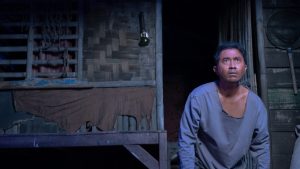Indonesia has a new hit series on its hands with Indonesian director Joko Anwar’s sci-fi smash “Nightmares and Daydreams,” which was released on the streaming service Netflix on June 14.
The seven-part anthology has been well received both locally and internationally, and is still in the Top 10 most-watched charts on Indonesian Netflix over a month after its release.
Yet the series, which features a gruesome underground cult, a time-traveling cinema and a myriad of angels, aliens, and monsters, is more than just an extravaganza of gore and dizzying plot twists.
Instead, each episode is tightly drawn to reflect a social issue in Indonesian society, set against a backdrop of science fiction theater and fantasy.
In Episode One of the series, entitled “Old House,” down-on-his-luck taxi driver Panji struggles with the economics and the morals of placing his aging mother in a nursing home, while also trying to juggle his responsibilities as a husband and father to a young son.
The episode, which also features a Squid Game-esque cult complete with sinister LED fringed cloaks, speaks to the wider societal issue of care for the elderly in Indonesia, where the lack of social safety nets such as pensions and government support often means that families have to make up the shortfall and care for their parents in their later years.
As life expectancy in Indonesia continues to increase, data suggests that almost 12 percent of Indonesia’s population is elderly and that the number is predicted to rise to around 20 percent by 2045.
As detailed in a May 2024 opinion piece in the Jakarta Post, “Indonesia’s cultural expectations dictate that families take care of their elderly members, often by having them reside with or near their adult children. This practice symbolizes gratitude for parental upbringing and respect for elders.
“However, societal shifts, such as widespread migration for work and soaring housing costs, have strained this tradition. Children of elderly parents must precariously balance their own family’s lives with the demands of caring for their aging parents.”
With that in mind, Old House is a raucous sci-fi spin on the responsibilities and challenges faced by younger Indonesians in caring for their relatives – monsters and cults notwithstanding.
The cultural and social commentary continues apace in Episode Three, titled “Poems and Pain,” about a listless fiction writer called Rania whose last book has bombed and who reluctantly agrees to write the sequel to her previous bestseller, which tells the story of a woman who is being imprisoned and physically abused.
As she begins to write, however, Rania falls into a trance only to wake up with physical injuries to her body and completed chapters of the novel.
It is a challenging episode to watch, as Anwar portrays the abuse meted out to the victims in graphic detail straight to the camera, but while viewers may have to look past the possessed premise of the story, the lack of access to support for women of domestic violence is by no means an alien concept.
According to a 2023 World Health Organization report, one in four women in Indonesia is subject to physical or sexual violence.
The lack of accountability for the perpetrator at the end of the episode also rings true regarding the difficulties women face in reporting assault and the challenges in pursuing legal channels.
In Episode Four, “Encounter,” a lone fisherman named Wahyu is met by a mysterious angelic specter while out fishing one evening. After he manages to photograph the supernatural being, his local community, on the brink of facing eviction from their fishing village, plans to use the encounter to their advantage to convince the government that they should be allowed to stay.
Forced evictions of villagers from ancestral lands where they have often lived for generations is also another hot button issue across Indonesia, and Anwar deftly weaves this into a story about belief in the supernatural and the power of a local community fighting against all odds to survive.
Other episodes in the series delve into more gritty themes including extreme poverty, homelessness, mental health, unemployment, and Indonesia’s “sandwich generation.” The majority of episodes also focus on Indonesia’s working classes and the impossible task they face trying to dig themselves out of poverty.
Sci-fi is not a particularly popular genre in Indonesia, which meant that the series was something of a gamble for Anwar and Netflix, as Indonesian horror films and series still tend to dominate the box office and streaming services.
Yet despite the need to suspend disbelief as cast members of “Nightmares and Daydreams” fly through the air, fight off enemies and, in one episode, dangle precariously from a clock face, the series is one of the most real depictions of life in modern Indonesia ever to be presented on screen.

































